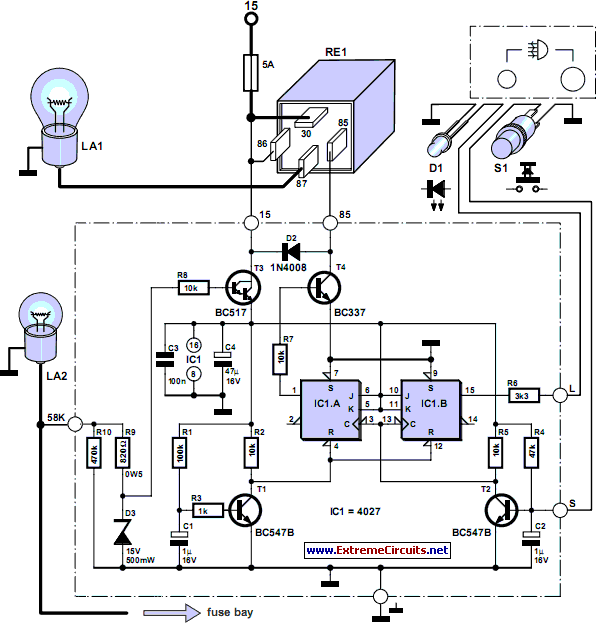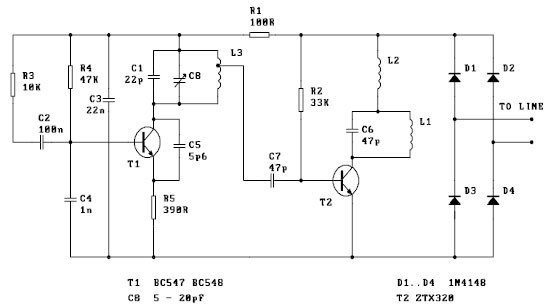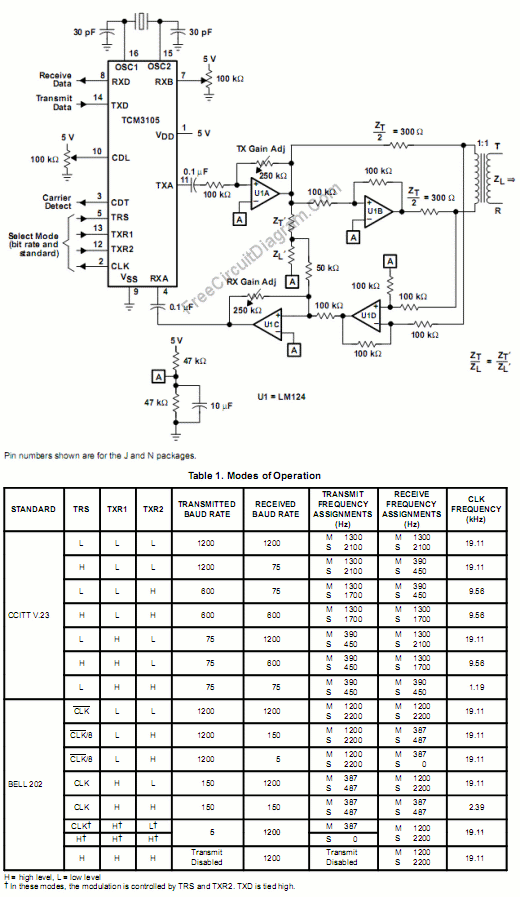
tl072 car subwoofer filter circuit

The circuit diagram depicts a simple subwoofer filter that operates on a 12V DC supply, making it particularly useful for automobile subwoofer applications. This circuit functions as a low-pass filter, with an adjustable pass frequency ranging from 60 to 160 Hz. It is based on the TL072 dual BIFET operational amplifier IC. Within the chip, one of the two opamps, designated as IC1A, is configured as a buffer. The left and right audio inputs are mixed and fed into the input of IC1A via a DPDT switch, labeled S1. This switch serves as a part control switch, allowing the user to create the subwoofer effect in conjunction with different speakers. When S1 is set to position 2, a 180-degree phase shift is introduced. The level can be adjusted using the potentiometer R7, while IC1B implements the low-pass filter, with its cutoff frequency adjustable through the dual gang potentiometer R13.
The subwoofer filter circuit is designed to enhance the bass response in audio systems, particularly in automotive environments where space and power constraints are prevalent. The TL072 opamp is chosen for its low noise and high-speed performance, which is essential for maintaining audio fidelity. The buffer configuration of IC1A ensures that the audio signal retains its integrity while allowing for impedance matching between the audio source and the filter circuit.
The DPDT switch S1 plays a critical role in the circuit by allowing the user to select between different configurations, enabling flexibility in the audio output. Positioning the switch to induce a 180-degree phase shift can help in optimizing the subwoofer performance, especially in setups where multiple speakers are used, ensuring that sound waves are properly aligned for a coherent audio experience.
Potentiometer R7 serves as a volume control, enabling the user to adjust the output level of the subwoofer, thus providing a tailored listening experience. The low-pass filter implemented by IC1B is crucial for eliminating high-frequency noise and allowing only the desired bass frequencies to pass through. The adjustable cutoff frequency, controlled by the dual gang potentiometer R13, provides the ability to fine-tune the filter's response, accommodating various audio preferences and speaker characteristics.
Overall, this subwoofer filter circuit is a versatile solution for enhancing low-frequency audio performance in automotive applications, combining simplicity and effectiveness in design.Here is the circuit diagram of an easy subwoofer filter that can be operated from a 12V DC supply. Such a circuit is incredibly helpful in automobile subwoofer applications. The circuit is nothing however a low pass filter whose pass frequency can be adjusted between 60 to 160 Hz. The circuit is designed based on the TL072 dual BIFET opamp IC. Out of the two opamps inside the chip, IC1A is wired as a buffer. The left and right audio inputs when mixing is fed to the input of the IC1A using the DPDT switch S1. Switch S1 is the part control switch which can be used to create the subwoofer in part with different speakers.
When S1 is in position 2, 180 degree part shift will be induced. POT R7 can be used for controlling the level. IC1B forms the low pass filter whose pass frequency can be controlled by adjusting the dual gang POT R13. 🔗 External reference
The subwoofer filter circuit is designed to enhance the bass response in audio systems, particularly in automotive environments where space and power constraints are prevalent. The TL072 opamp is chosen for its low noise and high-speed performance, which is essential for maintaining audio fidelity. The buffer configuration of IC1A ensures that the audio signal retains its integrity while allowing for impedance matching between the audio source and the filter circuit.
The DPDT switch S1 plays a critical role in the circuit by allowing the user to select between different configurations, enabling flexibility in the audio output. Positioning the switch to induce a 180-degree phase shift can help in optimizing the subwoofer performance, especially in setups where multiple speakers are used, ensuring that sound waves are properly aligned for a coherent audio experience.
Potentiometer R7 serves as a volume control, enabling the user to adjust the output level of the subwoofer, thus providing a tailored listening experience. The low-pass filter implemented by IC1B is crucial for eliminating high-frequency noise and allowing only the desired bass frequencies to pass through. The adjustable cutoff frequency, controlled by the dual gang potentiometer R13, provides the ability to fine-tune the filter's response, accommodating various audio preferences and speaker characteristics.
Overall, this subwoofer filter circuit is a versatile solution for enhancing low-frequency audio performance in automotive applications, combining simplicity and effectiveness in design.Here is the circuit diagram of an easy subwoofer filter that can be operated from a 12V DC supply. Such a circuit is incredibly helpful in automobile subwoofer applications. The circuit is nothing however a low pass filter whose pass frequency can be adjusted between 60 to 160 Hz. The circuit is designed based on the TL072 dual BIFET opamp IC. Out of the two opamps inside the chip, IC1A is wired as a buffer. The left and right audio inputs when mixing is fed to the input of the IC1A using the DPDT switch S1. Switch S1 is the part control switch which can be used to create the subwoofer in part with different speakers.
When S1 is in position 2, 180 degree part shift will be induced. POT R7 can be used for controlling the level. IC1B forms the low pass filter whose pass frequency can be controlled by adjusting the dual gang POT R13. 🔗 External reference





